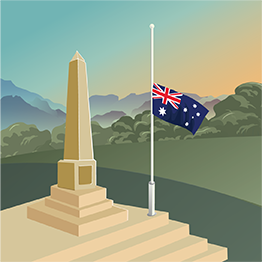Flags are flown in the half-mast position as a sign of mourning.

To bring the flag to the half-mast position, the flag must first be raised to the top of the mast (the ‘peak’), then immediately lowered slowly to the half-mast position. This position is estimated by imagining another flag flying above the half-masted flag – in European mythology, the flag flying above is the flag of death. The flag must be lowered to a position recognisably half-mast so that it does not simply appear to have slipped down from the top of the flagpole. An acceptable position would be when the top of the flag is a third of the distance down from the top of the flagpole.
When lowering the flag from a half-mast position, it should first be raised briefly to the peak, then lowered ceremoniously.
A flag should not be flown at half-mast at night, whether or not the flag is illuminated, unless direction to half-mast the flag for an extended period of time has been issued.
When flying the Australian National Flag with other flags, all flags in the set should be flown at half-mast. The Australian National Flag should be raised first and lowered last.
There are occasions when direction will be given by the Australian Government for all flags to be flown at half-mast.
Some examples of these occasions are:
- On the death of the Sovereign (King or Queen) – the flag should be flown from the time of announcement of the death up to and including the funeral. On the day the accession of the new Sovereign is proclaimed, it is customary to raise the flag to the top of the mast from 11 am until the usual time for closure of business.
- On the death of a member of the royal family – by special command of the Sovereign and/or by direction of the Australian Government.
- On the death of the Governor-General or a former Governor-General.
- On the death of a distinguished Australian citizen, in accordance with protocol.
- On the death of the head of state of another country with which Australia has diplomatic relations – the flag would be flown at half-mast on the day of the funeral or as directed.
- On days of national commemoration such as Anzac Day and Remembrance Day.
Flags in any locality may be flown at half-mast on the death of a local citizen or on the day, or part of the day, of their funeral without the direction from the Australian Government.
